NAB 2018: Over in Las Vegas this week, the Ultra High Definition (UHD) picture started to become a lot clearer.
Momentum may have been slow, but 4K and High Dynamic Range (HDR) are now a staple part of broadcasting’s future with a surfeit of ways to capture both formats which, combined, make for a stronger UHD proposition.
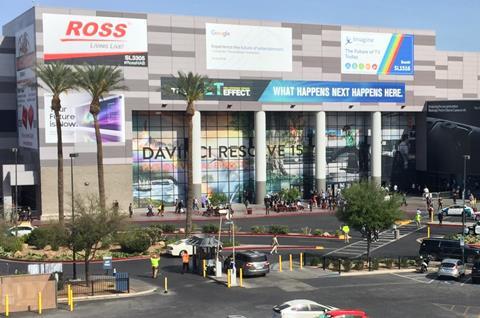
Consumer 4K displays are shifting. Half of TV sets shipped in Western Europe and more than this in North America and China are now 4K, according to the latest IHS Markit stats. Large screens at 55-inches up to 65-inches are heading demand.
This means that from a consumer perspective “UHD is becoming commonplace with a variety of devices and distribution platforms now available,” according to Futuresource Consulting.
However, from an industry stand point “there is still a significant amount of ongoing grappling with the technology - more specifically, justifying and providing the return on investment across both hardware and content.”
The broad consensus is that UHD take up has been steady but not stellar, with just 0.17% of all TV channels distributed using satellite being UHD today (this includes DTH platforms and video distribution to cable TV and IPTV headends, according to NSR statistics).
Satellite service provider Eutelsat says the number of UHD channels has grown by 26% in the past six months to reach 125. To put that in perspective, according to Eutelsat research, just 27% of the 11,700 total global number of TV channels are in high definition – the rest still being SD - despite the first digital HD commercial channel launch in 2003.
UHD is a slow burn even in markets like the UK where BT and Sky have pioneered services. There’s no sign yet of public service broadcasters the BBC and ITV launching a 4K service, not even to time with the FIFA World Cup this summer.
A boost in consumer interest in new formats is hoped for around such major events but the impact is likely to be higher in countries like Germany where broadcasters are actually transmitting it. Instances of HDR outside of streaming services like Amazon Prime are rarer still, although many broadcasters including the BBC have tested it extensively.
While distribution remains a bottleneck, the amount of content recorded in 4K and higher resolutions continues to ramp up. Content owners at least are confident of the day when UHD becomes the defacto viewing standard – for studio and news programming too.
Studio cameras are becoming more capable with many introducing higher frame rates both for slow motion replays and potential next generation UHD broadcasts.
There are a number of cameras which can be switched to operate in live broadcast or cine-style in UHD. Several also come equipped with dual ISO modes – the sensitivity to record better pictures in shadows or lower light conditions with an eye to HDR.
And in another nod to the need to deliver greater latitude and colour information to the final output, there are developments to record in the raw, unfiltered or extremely lightly compressed images straight out of the camera.
Sony took the wraps off three 4K XDCAM camcorders, two of which are trained on news gathering and one of which was billed as the “world’s first 4K three-chip handheld camcorder”.
The PXW-Z190 is built around three 1/3” CMOS sensors designed for a fixed 25x optical zoom lens. It incorporates face detection autofocus and will record simultaneous 4K and HD proxies to two SD cards as well as having 12G-SDI output. There’s a WiFi module or optional cellular modem for live streaming. It replaces the existing PXW-X200 in Sony’s line-up and is expected to ship in July.
The similar but less full featured Z280 has 1/3-type CMOS sensors, a 17x built-in optical zoom and manual control rings for zoom, iris and focus. It also shoots 4:2:2 10-bit 4K at up to 60p, but records to SD card only and is limited to 3G-SDI output. It’s set to ship in September when pricing will be announced.
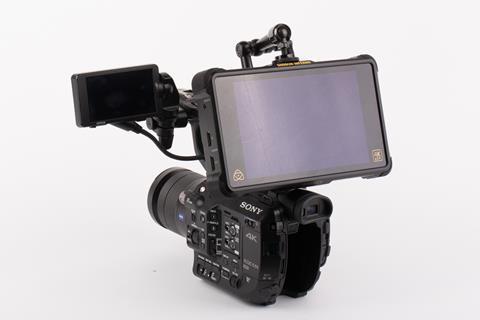
For those looking for a more cinematic look, the FS5II is a 4K Super 35mm imager which updates the original FS5 with fresh colour science adapted from Sony’s Venice cine camera that improves skin tones.
It boasts high framerate capabilities too. Internally, the camera can shoot at 240 fps in full HD for up to eight seconds, or continuously at 120 fps. To an external recorder it will record 60 fps 4K recording, four second bursts of 4K video at 120 fps or continuously 240 fps in HD. If the Atomos Shogun Inferno recorder is used to that also means you can capture Raw 4K using Apple’s new ProRes RAW format. The body is priced at $4750 (€3690 / £3222) or $5250 with a 18-105mm f/4 kit zoom.
Sony’s Venice camera came to NAB complete with a software update for variable frame rates and reports of its adoption by Netflix to shoot several drama series. New accessories for the camera include a MultiDyne Silverback system that permits the output of a live 4K signal over fibre while simultaneously recording 6K in the camera; and integration of Teradek Bolt, a wireless transmission unit which will allow raw and X-OCN (Sony’s codec) recording without cables.
Blackmagic Design’s philosophy is to make 4K UHD broadcast “affordable”, breaking ground in February when it unveiled a sub-£2500 (€2800) UHD broadcast camera that can be used for both studio and live production work. The release was timed so as not to clash with BMD’s main NAB promotion of a 4K Pocket Cinema Camera.
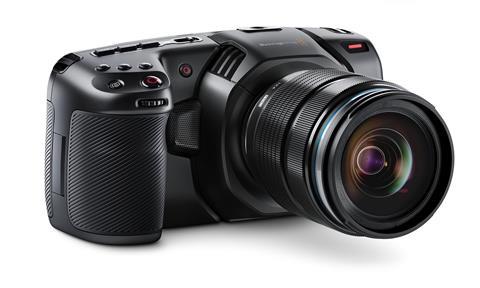
This ups the resolution from the company’s previous 2.5K handheld model, shoots at 60fps (or 120fps in HD) and deploys the same MFT (Micro Four Thirds) lens mount as the original. It houses a dual ISO with a maximum sensitivity of 25,600 for low light performance as well as 13 stops of dynamic range. It also eliminates the need for what BMD calls “expensive external recorders”, as it can use the internal SD/UHS-II and CFast recorders or record directly to the same external disks users may have for editing and colour correction. It costs $1295 (€1050/£914) on retail in September.
For live switching of 4K camera feeds BMD also revealed more details of the ATEM Television Studio Pro 4K, which combines a broadcast hardware control panel with an eight input 12G-SDI switcher for working in HD and UHD. The switcher costs less than $6000 and houses the firm’s Fairlight audio mixer and 16 chroma keys.
Panasonic added software upgrades to its flagship cine-style cameras, the EVA1 and VariCam LT. The latter can now operate as a live TV camera as well as for drama with the update, while cinematographers can now take full advantage of new ProRes Raw workflows from Apple straight out of the EVA1.
However, it directed most of its attention to unmasking the AK-UC4000, a $40,000 (€32k) studio camera with a super 35mm sensor, 4.4K resolution and 240 fps capability (to be introduced through a software upgrade around IBC-time) targeting live sports and high-end event productions.
One advantage of the ‘oversampling’ applied by the UC4000’s 4.4K sensor is that helps avoid potential moiré (aliasing) issues caused when photographing LED screens around venues.
Panasonic is also releasing a $20k (€16,000) Camera Control Unit (CCU) for the camera providing power up to 6,600 feet and able to transport simultaneous 4K and HD, simultaneous HDR and SDR outputs with the ability to adjust for SDR shading of HDR content.
Red seems to develop a new sensor every other week, coming closer to the day when a cinematographer might select a particular sensor for a particular job much like they would once have chosen film stock. Swappable into its EPIC-Weapon camera body, the latest chip called Gemini was originally designed for cameras used on the International Space Station, now modified for terrestrial use and especially low light photography.
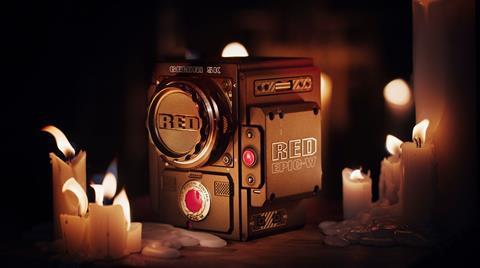
It can capture 5K at up to 16.5 stops of dynamic range, can shoot up to 96fps and is capable of recording all the expected Redcode RAW, ProRes and DNxHR formats. In similar fashion to the sensors found in Panasonic Varicam or EVA1 cameras, the Gemini can be switched to function from low light to ‘normal’ light modes.
An Epic-W chassis with Gemini will cost $24,500 (€19,800) to buy. Alternatively, Weapon Carbon Fiber and Red EPIC-W 8K customers will have the option to upgrade to the Gemini sensor at a later date.
No sight though (at least publicly) of Hydrogen One, a smartphone with holographic display that integrates within the wider Red camera range.
Having achieved its goal of making a camera worthy of being the ‘A’ camera on major Hollywood productions with the EOS C700, Canon has set its sights on developing a full-frame cinema camera. The result, debuted at NAB, is the EOS C700 FF, a $33k (€26.7k) imager with a newly developed CMOS sensor and 17:9 aspect ratio. In addition to full-frame lenses, it can be used with conventional S35mm lenses to originate 4K/UHD productions and Super 16mm lenses (with an adapter) to originate HD shows in crop modes.
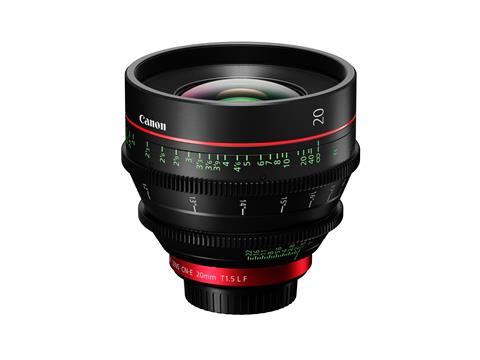
A notable feature of the C700 FF is the oversampling 4K processing that processes a 5.9K image capture to produce 4K (DCI or UHD) having enhanced image sharpness, curtailed moire, and a lowered visibility of noise at the higher ISO settings. This is advantageous for on-board anamorphic image capture.
It wears its Hollywood credentials on its sleeve by supporting the ACES (Academy Color Encoding System) colour management standard as well as 15 stops of latitude (with Canon Log2 only) for HDR. It will be available in both PL and EF Mount versions from July.
HDR: now essential
With content creators increasingly committing to having original programming created in UHD and HDR this was as a major emphasis at NAB, for live as well as recorded shows.
Grading and delivering HDR pictures though has not settled into any standard and this is causing delays in rolling out UHD HDR broadcasts. Arguably the most significant Achilles heel for post-producing HDR is the cost of mastering monitors which can tend to start around E20,000, outside the scope of many smaller facilities.
Canon for example debuted two reference displays for 4K HDR production but declined to put a price on them. The DP-V1711 is a 17-inch 4K display for studio monitoring or outside broadcast. Both monitors support HLG and Perceptual Quantization (PQ) and feature four 12G-SDI inputs, which can deliver 4K 50P transmission through a single cable. Comparisons with SDR are also possible in split screen mode.
Tyler Pruitt who works for HDR specialist Portrait Displays questioned whether a client monitor was even required. He informed the SMPTE Digital Cinema Summit that scripted TV shows are already using OLED TVs as both the reference and client monitor. Even better, you can buy an OLED TV for €1500, potentially solving the affordability issue of HDR reference monitors.
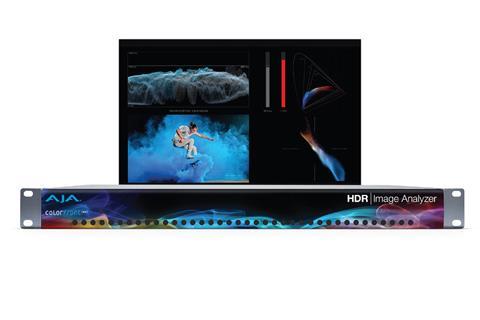
AJA Video Systems previewed a HDR Image Analyzer, a collaboration with Colorfront. This includes waveform, histogram, vectorscope and Nit level HDR monitoring intended to simplify analysis of HDR content from production to mastering with a specific colour calibration for Arri, Canon, Panasonic, RED and Sony cameras.
“As 4K/HD, HDR/WCG productions become more common, quality control is key to ensuring a pristine picture for audiences,” said Nick Rashby, AJA’s president.
All three of Sony’s new 4K camcorders for example support Instant HDR, a Sony specific workflow which bakes HDR into the live output (in HLG format) for broadcast or on set previews, while leaving wriggle room for finessing the grade in post.
“HDR is secondary, as the money is still related to the HD production, which needs to be sacrosanct,” explained Rob Willox, director, marketing, Sony Professional Solutions at Sony’s press event. “The HDR production cannot impact the main broadcast, and it also needs to use the same equipment and technicians so that there is less additional workflow and two broadcasts can be done without increasing the budget.”
Generating live simultaneous signals at acquisition is critical for an HDR transition when live SDR signals are still needed to support legacy infrastructure, screens, or channels. Both Hitachi and Panasonic demonstrated how their 4K cameras can simultaneously output HDR and SDR signals. Hitachi presented side by side comparisons of the image from a SK-UHD4000 in a darkened area on it booth to highlight the enhancement.
“Our position is that HD HDR gives more bang for the buck and is a more visually appealing picture than UHD with standard dynamic range,” said John Humphrey, Hitachi’s VP of Business Development.
The next stage
The stage is being set for the next advance in 4K TV which moves the format away from basic toward richer audio and visual profiles. The Ultra HD Forum has laid some of the groundwork for this in publication of ‘Phase B’ guidelines detailing what companies should aim for with future 4K broadcast tech. This includes high frame rates up to 120fps, an advanced method of HDR using dynamic metadata HDR and next-gen audio for more elaborate sound.
While these developments will call on a new 2.1 version of HDMI to throughout the higher bandwidth the UHD Forum also expects to use Content Aware Encoding where encoders reduce data use in relatively stationary scenes to lower the requirements.
8K joins the conversation
4K is often spoken of in terms of ‘4K and higher’ resolutions meaning that many cameras already exceed the 4K UHD broadcasting and cinema baseline. As it stands capturing resolutions above 4K are largely used in order to better drill into or manipulate the image without losing overall quality on a HD or 4K output.
Panasonic for example demonstrated a 8K ‘Region of Interest’ system for sports and live event HD applications in which a single camera operator can zoom into the a panoramic single 8K picture and create HD windows with full pan/tilt/zoom control. It’s a space and operator cost saving application.

The centrepiece of Sony’s exhibit was a 32 x 18 ft Crystal LED wall showing 8K 120fps footage from its new UHC-8300, a three-chip 8K x 4K camera system for broadcast. A similar screen will used by Fox Sports in Russia for its coverage of the 2018 World Cup.
Fellow Japanese vendor highlighted a range of 8K products including a camcorder, 70” video monitor and a display with eight panels for showing different angles. These were demonstrated with HDR and are intended to fit into the broadcast system which NHK is planning to switch on at the end of 2019.
NHK itself continued to push the boundaries of 8K production with an 8K theatre screen showing natural history and ballet content and an exhibit of 360-degree virtual reality video in 8K, a feat it intends to pull off live with the help of Intel during the Tokyo Olympics in 2020.
Meanwhile, Ikegami touted its 8K credentials while Sharp showed 8K cameras, transmission kit and screens.
Not at NAB 2018? Catch up on show news and highlights in this IBC365 Webinar
























No comments yet